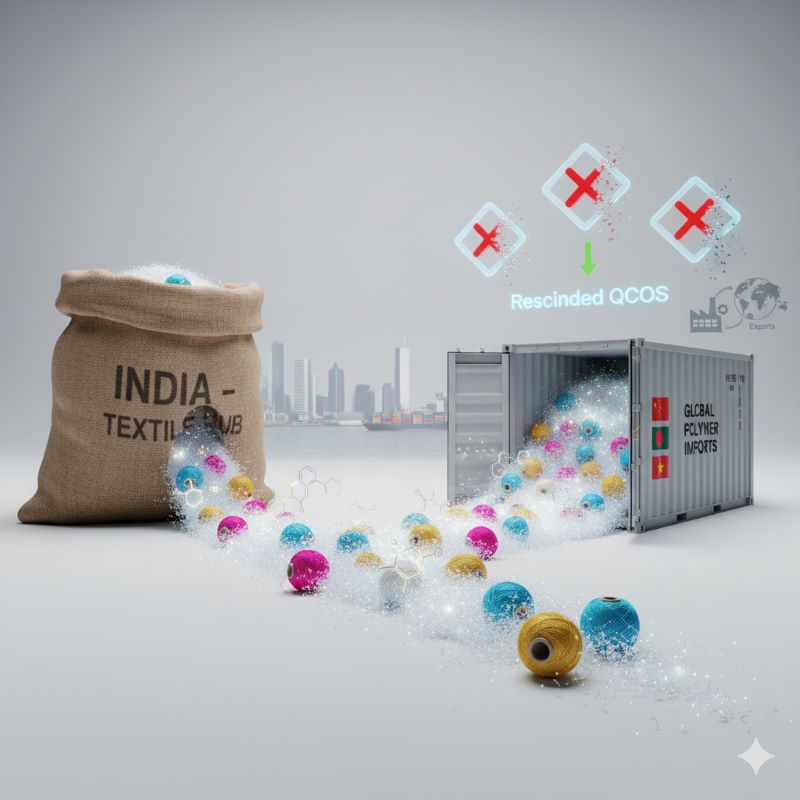India is losing its market share in cotton and man-made fiber, as most products are made of coarse count yarn and man-made fiber prices are at least 25 per cent higher than rates prevailing in competing countries. Of the 864 textile and apparel commodities traded in 2012, India’s share was less than one per cent in at least 317 commodities. This is mainly because of the high duty structure on man-made fibers and the basic customs rate.
Unlike other sectors of the Indian textile industry, the synthetic fiber industry is an organised sector. The main products of synthetic fiber industry include man-made fiber and yarn. These man-made fibers and yarns constitute textiles of both cellulose and non-cellulose origin. The products includes polyester staple fiber, acrylic staple fiber and polypropylene staple fiber.
Slashing duty on man-made fibers is also expected to increase cotton consumption as demand for cotton-blended fabric is growing exponentially. Blends like cotton rich polyester, viscose, bamboo and modal are gaining traction to take advantage of the feel of cotton and the functionality of synthetic fibers. So the more synthetic blends the country spins, the higher will be the consumption of cotton.
India loses market share in synthetic fiber
- 1
- 2
- 3
- 4
- 5
- 6
- 7
- 8
- 9
- 10
A Punishing Paradox: Is Made in America unravelling the US textile industry?
The Make America Great Again (MAGA) is initiative aimed at breathing new life into US manufacturing, but its impact on... Read more
India's Textile Sector Sews Up Global Trade Alliances in Singapore: Focus on FTA…
The future of India’s textile and textile machinery sector is poised for exponential growth, driven by strategic international collaborations, notably... Read more
QCO rollback and export boost, the two-step formula powering India’s textile com…
November 12, 2025, could go down as a watershed date in India’s textile history. In a single day, the government... Read more
Cotton's Comeback: Brazil's blueprint for a natural fiber renaissance
The global textile industry operates on an assumption: natural fibers are nearing their ceiling of growth, with future demand almost... Read more
India's $2.92 bn export surge drives focus on performance, policy at Techtextil …
In line with its momentum to establish itself as a global textile manufacturing powerhouse, India is accelerating its focus on... Read more
Fashion’s new equation, profits meet planetary limits at Lisbon’s Textile Exchan…
The Textile Exchange Conference 2025, held under the theme ‘Shifting Landscapes’, marked more than another industry meet-up; it was a... Read more
India Scraps QCOs on Polyester, Polyester Fibre: A level playing field or domest…
In a major policy reversal, the Ministry of Chemicals and Fertilizers, through a notification in the Gazette of India dated... Read more
Is secondhand fashion the new fast fashion?
The fashion industry has long touted secondhand shopping as a silver bullet for sustainability, a movement that redefines style through... Read more
Source Fashion 2026: Championing collaboration to drive sustainable supply chain…
Europe’s premier fashion sourcing show, Source Fashion, is set to double down on the power of collaboration for its upcoming... Read more
Bharat Tex 2026: A premier event for the global textiles and apparel industry
A key consortium of leading Export Promotion Councils (EPCs) and industry associations, the Bharat Tex Trade Federation (BTTF) is set... Read more












